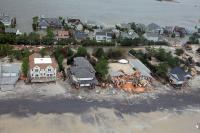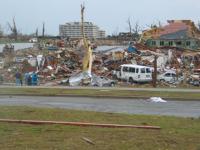-
Strengthening U.S. infrastructure to withstand disasters
The delivery of essential services — whether in food, water, health, or emergency response — relies increasingly upon a complex, interconnected system of critical infrastructure. Ensuring these interdependent systems continue to operate during disasters and other disruptive events is crucial to maintaining public health and safety. NSF announces $22.7 million in new investments to promote better understanding and functioning of these infrastructures in an effort to improve their resilience.
-
-
$3 million grant to build terrorism, disaster resilience
LSU Health New Orleans School of Medicine’s Department of Psychiatry has been awarded a $3 million grant over five to build the Terrorism and Disaster Coalition for Child and Family Resilience, with a focus on terrorism and disasters. The purpose of the Coalition is to create effective partnerships in disaster-prone regions to enhance national capacity to prepare and respond to the unique needs of children, adolescents, and families after disasters and terrorism.
-
-
Recent history of U.S. floods shows regional trends, but no national pattern
A new study examined the recent history of floods in the United States for the time period 1940-2013. The scientists found some regional trends, but no widespread national pattern of flood change. “An important prerequisite for effective flood risk management is to have an accurate assessment of how flooding is changing over time,” said one researcher. “Of course, changes in climate as well as land- and water-use management are each potential sources of change in flooding frequency or magnitude. But the relative influence of these factors across broad areas has been difficult to discern.”
-
-
Insights on Deepwater Horizon disaster
The soon-to-be-released thriller “Deepwater Horizon,” which opens in theaters 30 September, promises moviegoers a chilling reenactment of one of history’s worst oil rig disasters. One scholar of societal collapse will enter the theater with a big-picture view of the perfect storm of factors that led to the explosion and oil spill that killed eleven people and sent more than 200 million gallons of crude oil spewing toward the nation’s southern coastline for eighty-seven days.
-
-
Tackling rumors during crises
The proliferation of rumors during a crisis can hinder efforts by emergency personnel trying to establish facts. That is why a doctoral student at BGU’s Department of Emergency Medicine has developed a methodology for tracking rumors and guidelines for how to control them.
-
-
Social media helps build a sense of community in the aftermath of disaster
After natural disasters communities rely heavily on local governments to provide the necessary resources and information to respond to such disasters, but these approaches are not well equipped to meeting individual needs. As a complement to traditional methods, social media can provide a more personalized resource as well as fostering a sense of community in response to the crisis.
-
-
Optimizing choice of post-disaster recovery options by analyzing entire cities
Civic leaders and engineers are typically faced with a very large number of possible recovery options in the aftermath of a major catastrophic event, such as a hurricane or an earthquake. “If you are trying to solve a problem that has, say, ten possible outcomes — you can probably find a way to figure out which one is optimal; [b]ut what if the possible solutions number as high as 10 to the 120th power?” ask researchers. They have developed a versatile and novel technique which is the first to factor in so many elements, demonstrating its effectiveness on transportation network recovery in imagined post-earthquake San Diego.
-
-
Suburban sprawl and poor preparation worsened flood damage in Louisiana
The proximate cause of this month’s extraordinary flooding in southeast Louisiana was a slow-moving storm system that dropped up to two feet of rain in the upper reaches of the Amite and Comite river basins, which drain southern Mississippi and flow into Lake Pontchartrain. There are parallels between the damage of current flooding and the damage caused by Katrina. In both cases, human decisions magnified the consequences of extreme natural events. Planning and permitting enabled development in areas that had experienced repeat floods, and agencies had failed to complete projects designed to mitigate flood damage before the storms hit. If there is one lesson we have learned about floods, it is that records are made to be broken. So in addition to planning for the last flood, we need to anticipate higher water than our current benchmarks.
-
-
Germany to unveil a civil defense plan calling on citizens to stockpile food, water
The German government will tell citizens to stockpile food and water in their homes in order to prepare for a terror attack or catastrophe. The German cabinet will on Wednesday debate an Interior Ministry report, called the “Concept for Civil Defense,” which, among other things will require the population to stockpile enough food ten days and water for five days.
-
-
NIST leads federal effort to save lives, property from windstorms

Congress recently designated NIST to be the lead agency for the National Windstorm Impact Reduction Program (NWIRP). In one of its first actions as lead agency, NIST has announced in the Federal Register that it is establishing a panel of external experts to “provide advice on windstorm impact reduction and represent related scientific, architectural and engineering disciplines.”
-
-
Lessons learned from the U.S.-Canada cross-border experiment
A tornado has just devastated a community on the border between the United States and Canada. Paramedics scramble to bring patients from over-crowded hospitals across the border. Communication blackouts and downed trees force ambulances to weave their way through blowing debris, fallen electrical lines, and car wrecks. The time for a routine trip from the injury site to the hospital has now tripled. While this did not really happen, it was the focus in April when the DHS S&T and several Canadian government agencies collaborated on a cross-border experiment with a focus on preparing emergency responders for this type of scenario.
-
-
Colorado county adopts NIST community resilience guidelines
The Boulder County Collaborative, a partnership of Boulder County, Colorado, communities formed in response to the catastrophic floods that struck the region in September 2013, has used the NIST Community Resilience Planning Guide for Buildings and Infrastructure Systems to develop and adopt its own resilience design performance standard for community facilities and infrastructure systems.
-
-
New USGS models help predict storm effects on beaches

As the 2016 hurricane season opens, weather forecasters, emergency managers and coastal residents have access to tools developed by the USGS which predict, more precisely than ever, where beach erosion and beachfront flooding will take place during hurricanes and other storms.
-
-
Improving national resiliency: Joplin tornado 5th anniversary

Disaster struck Joplin, Missouri, on 22 May 2011, when the deadliest and costliest single tornado in U.S. history left a 22-mile long path of destruction. The storm killed 161 people, destroyed some 8,000 structures, and left $2.8 billion in damages in its wake. In the five years since the tragedy, the National Institute of Standards and Technology (NIST) has led the effort to learn from the devastation and make improvements based on those lessons so that communities nationwide can become more resilient to tornadoes, significantly reducing both deaths and property damage.
-
-
“G-Science” academies call for strengthening global disaster resilience

In the decade between 2005 and 2014, more than 6,000 natural and technological disasters occurred around the world, killing more than 0.8 million people, displacing millions more, and costing more than $1 trillion. Losses due to disasters are increasing in both developed and developing countries. Human factors that increase exposure and vulnerability, such as poverty, rapid population growth, disorderly urbanization, corruption, conflict and changes in land use, poor infrastructure including non-engineered housing, together with effects of climate change on weather patterns with increased extreme events, aggravate the negative consequences of natural and technological hazards.
-
- All
- Regional
- Water
- Biometrics
- Borders/Immig
- Business
- Cybersecurity
- Detection
- Disasters
- Government
- Infrastructure
- International
- Public health
- Public Safety
- Communication interoperabillity
- Emergency services
- Emergency medical services
- Fire
- First response
- IEDs
- Law Enforcement
- Law Enforcement Technology
- Military technology
- Nonlethal weapons
- Nuclear weapons
- Personal protection equipment
- Police
- Notification /alert systems
- Situational awareness
- Weapons systems
- Sci-Tech
- Sector Reports
- Surveillance
- Transportation
Advertising & Marketing: advertise@newswirepubs.com
Editorial: editor@newswirepubs.com
General: info@newswirepubs.com
2010-2011 © News Wire Publications, LLC News Wire Publications, LLC
220 Old Country Road | Suite 200 | Mineola | New York | 11501
Permissions and Policies
Editorial: editor@newswirepubs.com
General: info@newswirepubs.com
2010-2011 © News Wire Publications, LLC News Wire Publications, LLC
220 Old Country Road | Suite 200 | Mineola | New York | 11501
Permissions and Policies
